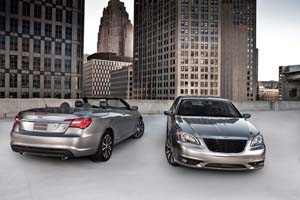The Chrysler 200 may have gotten an inspired start with an advertising campaign featuring rapper Eminem, but apparently the new nameplate is going to have a very short shelf life, TheDetroitBureau.com has learned.
Chrysler executives recently picked some new names for the next-generation models that will roll out of the company’s assembly plant in Sterling Heights, Michigan, where the 200 sedan and convertible are currently assembled.
The designs for the new C/D-sized cars, (compact in lay terms), which will be based on architecture from Fiat, have been frozen for some time and the names were finalized within the past week, suggesting Chrysler is completing plans for launching the new vehicles in roughly the next nine months or so.
The Chrysler 200 name itself was a stop gap after the automaker retired the Sebring badge, which had become badly tarnished by a poorly executed offering developed as part of the aborted three-way alliance between Daimler, Chrysler and Mitsubishi.
Chrysler executives are refusing to offer any hints about whether the names will come from the company’s traditional portfolio or shift into an entirely new direction. Retaining the 200 name would have a couple advantages: for one thing, it signifies a step down from Chrysler’s current flagship model, the 300 – though it would make it difficult to slot a midsize product in-between those two offerings.
There’s also the issue of cost: marketing an all-new mainstream nameplate can initially cost about $80 million to $100 million more than simply maintaining awareness for an existing name, industry marketers estimate. Just the well-received Super Bowl ad featuring Eminem, used to establish the 200 last January, cost about $10 million to produce and air.
But the downside is getting motorists to change their perceptions about a weak product, which appears to have convinced Chrysler planners that it will be better to start all over once the new line-up comes to market.
Meanwhile, Chrysler Group LLC is set to begin construction of a new $850 million paint shop at its assembly plant in Sterling Heights.
The official groundbreaking is set for Tuesday and follows the automaker’s announcement in October 2010 that it planned to overhaul the plant with a state-of-the-art paint shop for the production of future products.
Construction of the paint shop underscores the turnaround over the past two years in the fortunes of the plant, which currently employs approximately 2,000.
During the bankruptcy in 2009, the Sterling Heights Assembly Plant was assigned to the “old” Chrysler and was scheduled to close permanently sometime this year.
Chrysler bought the plant back from the entity disposing of its old assets in early 2010. It is now seen as a cornerstone of the “new” Chrysler, something CEO Sergio Marchionne underscored last month, when he used the Sterling Heights plant as a backdrop for the news conference announcing the automaker had paid off its remaining bailout loans.


Sounds like a bit of apples and oranges here…
1. The 200 is a midsize car, not compact (and I’d expect the replacement to be midsize, too).
2. There’s been some news lately about new names being selected, but that was for the Caliber replacement, not the 200 replacement. Of course, it’s possible they selected a name for the midsize cars, too.
3. The Caliber replacement, according to recent announcements, is also supposed to be launched within the nine-month time frame specified in this article. Chrysler’s previously announced business plan called for the 200 replacement in 2013, not 2012–and that makes sense, since it seems odd they’d replace the extensively-changed 200 after a little over a year. So they’ve theoretically got a bit more time to give a go/no-go on the 200 name.
Alpha-numerics are awful, unless they symbolize something like the 300 (300 hp, dating back to 1955), and even in that case, their usage should be limited. Chrysler would have done better to separate the 300c from “lesser” offerings.
In any case, good-ridance to the 200c which symbolized nothing but a “me-too” attempt to add euro-cache, and fits poorly with the “imported from Detroit” campaign.
Now, how to move Lincoln away from all its meaningless and confusing letter combos (MKZ, MKT, MKS, MKX)?
Hi, Carmine,
I will partially disagree. A well-conceived alpha-numeric badging strategy CAN work. I can’t see a Volvo Stockholm sedan, or a BMW Munchner wagon. a C30 Coupe and a 760i are relatively communicative and logical badges, indicating size and, for Volvo, that it’s a coupe or convertible. But what’s a Caddy DTS and how does it relate to a CTS and STS? Acura? Wow, names like RL and TL and the like damaged the brand severely/ And Lincoln’s “Mark” strategy was another foolish move. Elena Ford thought it would be cool to harken back to the best-known Lincoln Mark series, ie Mark II, but when it was abbreviated, ie MK S or MK T, consumers didn’t realize what they were being told to do, namely pronounce MK as “Mark.” So they didn’t and it became the worst of all worlds, two identical letters followed by a third that is meaningless and confusing. I know Lincoln owners who can’t remember what they have.
Then there is Mercedes. In days of old, when its line-up was limited, it was easy to figure out the hierarchy: C, E, S. And even the A- and B-Class additions were logical. But now we have CLs and CLKs, SLs and SLKs, and the original G, the Gallendawagen, is not a GL…or GLK. And the Old CLK, is that now the E Coupe or the other way around? Mercedes’ once-effective alpha strategy has been stretched to the breaking point.
Paul A. Eisenstein
Publisher, of TDB, er, TheDetroitBureau.com